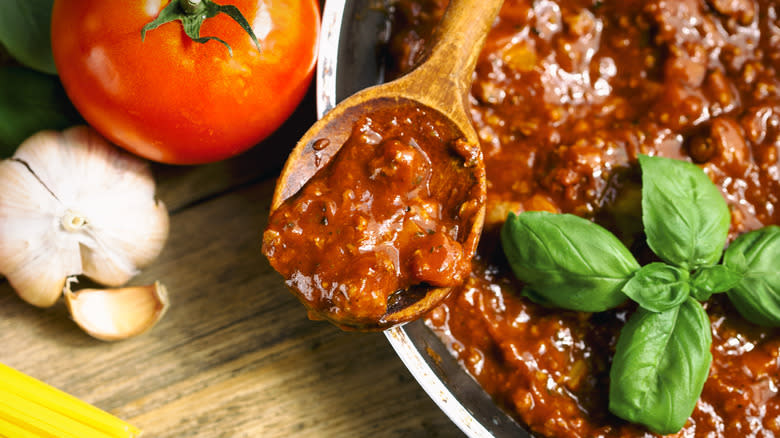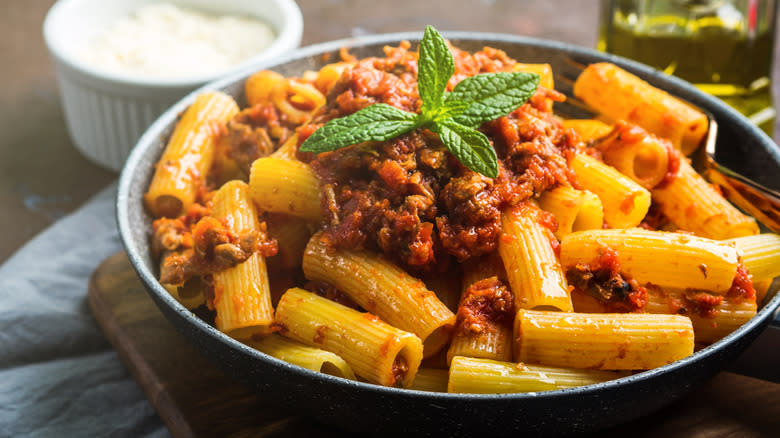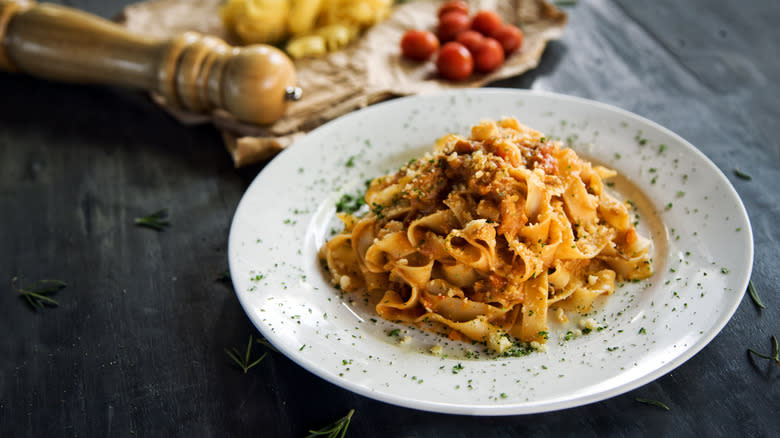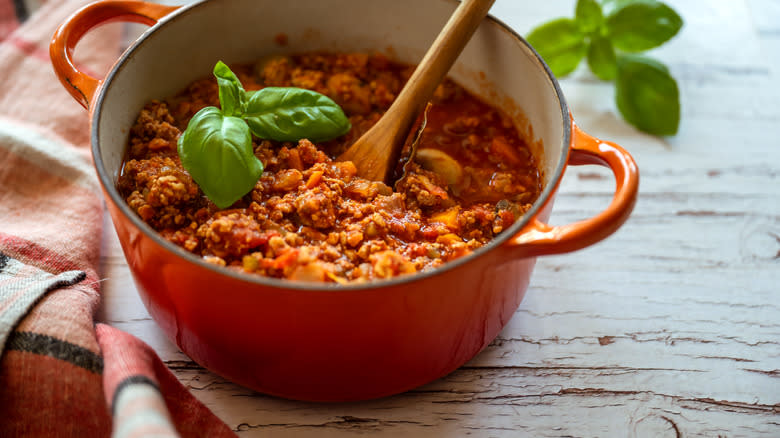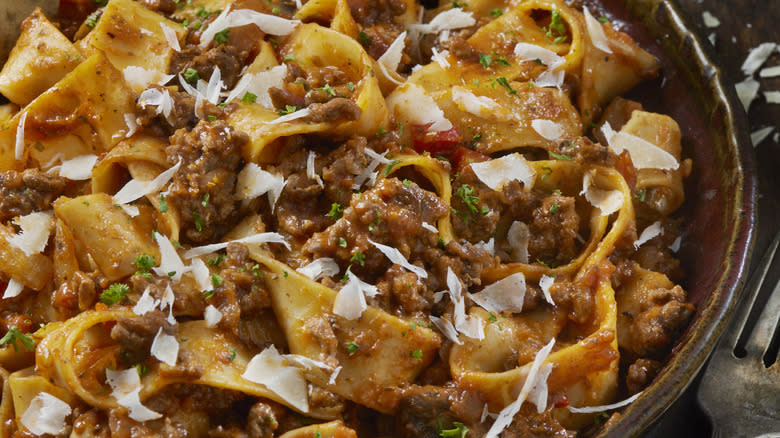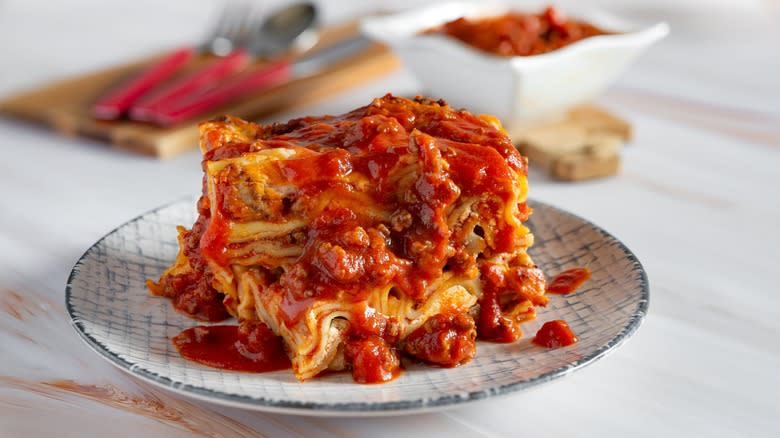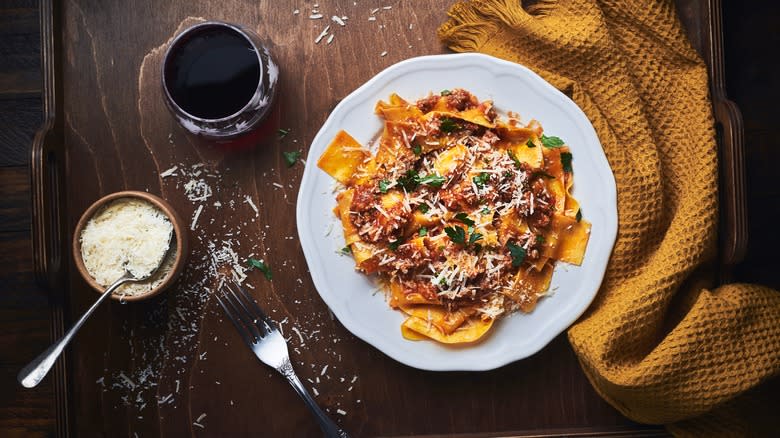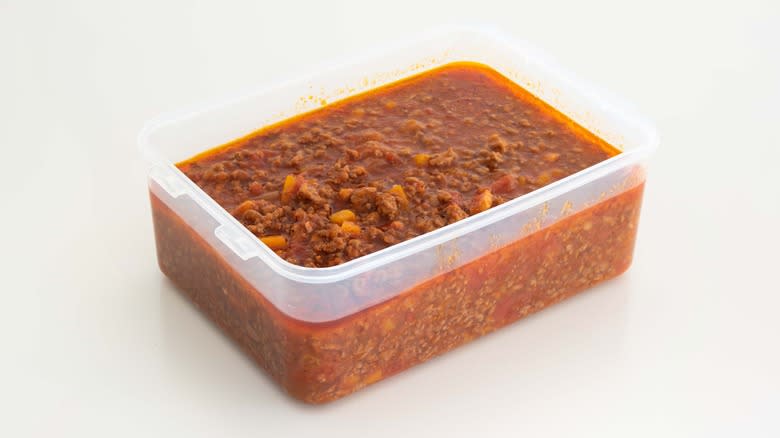Living in Italy, I have eaten a lot of delicious sauces. My favorite (perhaps because my Italian husband is so fantastic at making it) is ragù, a hearty, meaty tomato sauce that can be used to make anything from pasta to arancini, a deep-fried Sicilian street food. But even knowing ragù like I do, I can see how many people can get confused: What is the difference between the hearty, meaty ragù and the hearty, meaty, and also very popular Bolognese sauce?
If you think these sauces are very similar, you are right. Bolognese sauce is actually a form of ragù, meaning that they both start from the same basic recipe. In fact, Bolognese's official name is ragù alla bolognese or, in English, Bologna-style ragù.
While the two sauces do share many common traits, they're not exactly the same thing. For that reason, we're going to take a deep dive into the origins, ingredients, and other facts about both of them so that you'll have no trouble telling them apart.
ADVERTIsem*nT
Before we get started, however, we need to make one more distinction: The ragù we are talking about in this article is not Ragù, the popular brand of pasta sauce, but ragù with a small "r," which is a particular style of homemade Italian sauce.
Read more: French Cooking Tricks You Need In Your Life
What Is Ragù?
Ragù is made by cooking meats like beef or pork over low heat for a long time, with the addition of tomato sauce and perhaps some wine. It is eaten all over Italy (and in the U.S.) and has inspired many different regional variations, like ragù alla bolognese.
Ragù was invented in the late 1700s by a man named Alberto Alvisi, who worked as a chef making meals for the Cardinal of Imola. At the time, Italians were very interested in French food and culture, so it was no surprise that Alvisi was inspired by a meaty French stew called ragoût. Alvisi's version had minced meat, tomatoes, onions, pepper, and cinnamon. Meat stews had been popular in Italy for years before this, but this particular stew was served with pasta.
Though Alvisi's original recipe for "the Cardinal's ragù" fell into obscurity (it was eventually rediscovered by a pair of journalists in the 20th century), expanded-upon versions made ragù into a luxurious, high-class dish that was not very accessible due to the fact that both meat and the eggs used to make the pasta were expensive. After World War II, however, things changed, and pasta and meat were something even lower-class Italians could afford. While ragù is still often reserved for big Sunday meals, this is now just because of the time it takes to make it, not the cost.
What Is Bolognese Sauce?
For those who think that ragù and Bolognese are the same thing, this is where things might get a little confusing. Ragù alla bolognese, otherwise known as Bolognese sauce, is a form of ragù that was developed in Bologna. Or is it?
According to many sources, Bolognese is another of those classic "Italian" sauces like Alfredo that aren't actually eaten in Italy. In fact, the famous spaghetti bolognese is a dish more often eaten in Germany or Great Britain. But, in this case, Italy has decided to roll with it.
It's difficult to trace the actual origins of Bolognese sauce, but now Bologna is claiming it as its own. "Bolognese sauce is a challenge," Matteo Lepore, who works in the marketing department of Bologna's city council, tells LifeGate, "but it does in fact mirror the melting pot of this fine city. So is it all just a myth? Yes, but we'd better make the most of it."
So, in other words, no matter where Bolognese sauce really originated, it's considered to be a typical dish in Bologna now, which works fine for the true Bolognesi. As for the rest of us, the only thing you really need to know about this meaty sauce is that it is a form of ragù made with beef, white wine, and milk.
Ragù Is Made With Red Wine
When comparing ragù and Bolognese sauce, one need only look at the ingredients list to see the differences. In both versions, meat is the main ingredient, but ragù is typically made with minced meat while Bolognese is made with meat that has been cut into small pieces (not minced or ground). There is also a difference in the type of meat used, as ragù can include beef or pork, along with other meats like chicken, duck, goose, lamb, veal, game meats, or even organ meats. Bolognese purists say that the recipe for this sauce should contain only beef, but sometimes a small amount of fatty pork is added as well.
Both sauces also contain sautéed onions and carrots, but things diverge again when the liquids are added. Ragù typically sees an addition of some red wine early on in the cooking process, while Bolognese calls for white wine. Ragù also contains more tomato sauce, although it can be made in a "white" version that doesn't contain any tomatoes. Bolognese, on the other hand, is usually made with just a little bit of tomato paste and some added milk. This usually leads to the latter having a richer, creamier flavor and a more orange color, while the former is redder and tastes more like a (still rich) tomato sauce with a big, meaty flavor.
Bolognese Is Creamier
Considering the fact that they have a different set of ingredients (even if the difference is relatively slight in some cases), it's no wonder that the texture of these two sauces is different as well. Even though both are considered meat sauces and are thusly chunky, ragù is more like a thick tomato sauce with recognizable bits of ground beef within it. Bolognese, though, is creamier and thicker because it is made with milk. It is not considered to be a tomato sauce.
Surprisingly, this addition of milk is so essential to the recipe that the Bologna delegation of the Italian Academy of Cuisine released an official statement in 1982which mandated, in no uncertain terms, that official ragù alla bolognese contains milk. But ... rules are made to be broken, right?
Even chefs in Italy often disregard this statement and make Bolognese without the milk, which is good news for those who are lactose intolerant. If your Bolognese follows the "law," though, it will have a creamy, velvety texture thanks to the added dairy.
Ragù Can Go With Any Kind Of Pasta
Ragù was once reserved for fancy Sunday lunches, and even now it's seen as kind of a big deal since it takes hours to make and, let's be honest, is just that darned good. It can be paired with many different types of pasta, such as tagliatelle, penne, or paccheri, and it works particularly well with gnocchi, which holds its own against the strong flavor of the sauce.
Ragù is a must-have in Italian lasagna recipes, too, which usually come with the addition of béchamel. Since ragù usually brings a big, bold flavor and is very thick and meaty, it's best to use a thicker pasta with it, but it's still fine to eat it with spaghetti if that's all you have on hand.
Leaving pasta behind for a moment, ragù is also used in Sicily to make arancini, which are balls of rice flavored with saffron and stuffed with ragù, meat, and cheese before being coated in breadcrumbs and deep-fried. It can also be used to top a plateful of polenta.
Bolognese Pairs Well With Tagliatelle
Bolognese sauce is thick, meaty, and creamy, so it works best with wide, flat pasta like tagliatelle or egg noodles. This may come as a surprise to those in Germany and Great Britain, who are used to eating it with spaghetti!
You can of course eat your pasta however you like, but Italians recommend thicker pasta because it holds up better under the weight of the sauce. Thicker forms of pasta (especially homemade pasta) also lend a bit of their own flavor to the dish, whereas spaghetti fades into the background. Spaghetti may not hold the sauce as well, either, so you may wind up scooping up the remnants of yourBolognese with your fork when your pasta is gone. Or you can do as Italians do and collect it with a piece of bread, which this writer highly recommends.
If you'd like to use Bolognese in a lasagna recipe instead of ragù, you may want to leave the béchamel out. This is because Bolognese (if made in the "classic" way) contains milk on its own, so the dairy portion of the sauce could overwhelm the meaty flavor if you add the milk-based béchamel as well.
Both Sauces Can Be Stored In The Fridge For A Few Days
We've established that ragù and Bolognese are, indeed, different sauces, but they're still similar enough that the storage rules for one are true for the other. Both can be made in advance and reheated the next day, and it is recommended for both to be stored in a glass container in the refrigerator. They can both last around two or three days in the fridge if they are homemade. If you are using store-bought sauces, these may last a bit longer because they contain preservatives that the home-cooked versions do not.
If you would like your sauce to last longer than that, you can put it in the freezer. Simply put the sauce in a large freezer bag or a glass container with an airtight lid and place it in the freezer, where it will stay good for up to six months. When you want to reheat your ragù or Bolognese, simply take it out of the freezer and let it thaw out at room temperature for a couple of hours. Once there is no more ice remaining, you can heat up the sauce as usual and add it to the pasta of your choice.
Usually, tomato-based sauces last longer than dairy-based ones, so it could be that your ragù will be more resistant to spoilage than your Bolognese, if the latter contains dairy ingredients. If it doesn't, the two sauces should have almost exactly the same storage and reheating requirements.
Read the original article on Daily Meal.
